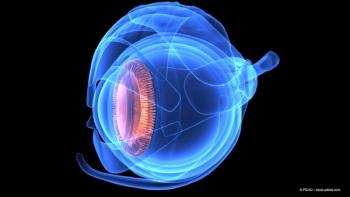
Exploring oral dual anti-VEGF/PDGF inhibitor for AMD
An oral anti-VEGF/PDGF inhibitor had no dose-limiting toxicity and improved visual acuity and OCT findings in patients with exudative age-related macular degeneration in a phase I study.
Reviewed by Nauman Chaudhry, MD
New London, CT-A phase II study investigating oral X-82 (Tyrogenex) in patients with exudative age-related macular degeneration (AMD) requiring frequent anti-vascular endothelial growth factor (VEGF) therapy is under way after positive results were achieved in a phase I study, said Nauman Chaudhry, MD.
The main objective of the phase I study was to evaluate the safety of X-82 and any dose-limiting toxicity. It was an open-label, ascending, repeat dose study that enrolled 35 patients with exudative AMD. Six regimens were evaluated with doses ranging from 50 mg every other day to 300 mg daily.
Recent:
Initially, only patients with heavily treated refractory disease were enrolled (patients unable to achieve a dry macula despite frequent anti-VEGF injections), but treatment-naïve patients were eligible for participation as the study progressed.
During treatment lasting up to 6 months, no dose-limiting toxicity was identified for X-82, and the investigational agent showed evidence of biological activity based on functional and anatomic endpoints.
Recent:
Dr. Chaudhry, principal investigator for the X-82 AMD studies and clinical assistant professor of ophthalmology, Yale University, New Haven, CT, noted that the investigational tyrosine kinase inhibitor has features that make it attractive for treating wet AMD.
“X-82 blocks kinase activity associated with all receptor subtypes of VEGF and also PDGF, which is important because anti-VEGF effects are enhanced by anti-PGDF activity,” he said. “Its oral route of administration makes X-82 suitable for treating patients with bilateral disease.”
Phase I research
The phase I study enrolled 35 patients who were treated for up to 6 months with one of six regimens: 50 mg every other day, 50 mg daily, 100 mg every other day, 100 mg daily, 200 mg daily or 300 mg daily. Patients returned every 4 weeks for assessment of BCVA and central foveal thickness (CFT) measured by spectral domain OCT. Patients were eligible for anti-VEGF rescue therapy if they had a 5-letter decrease in BCVA or a ≥50-μm increase in CFT.
Related:
Twenty-five of the 35 enrolled patients completed 6 months of treatment. BCVA was maintained or improved in most patients and was improved in the majority of the patients who completed the study. Mean CFT was also significantly reduced in the patients who completed the study, with some patients achieving complete resolution of fluid.
Of the 25 patients who completed the 6 months of treatment, 15 (60%) did not require any rescue anti-VEGF injections.
More retina:
“The proportion of patients in each dose cohort who did not require any rescue injections increased as the dose of X-82 increased,” said Dr. Chaudhry, who is in private practice, Retina Group of New England, New London, CT. “None of the patients in the 300 mg daily dose group who completed the study required anti-VEGF injections.”
Of the 10 patients who did not complete 6 months of treatment, 6 were withdrawn for adverse event-related reasons, including transaminase elevations (n = 2), leg cramps (n = 2), and gastrointestinal symptoms (diarrhea or nausea/mild anorexia, n = 2).
Expanding research
The phase II study is a randomized, double-masked, comparative dose (50, 100, and 200 mg daily) and placebo-controlled study. It is enrolling previously treated patients who have demonstrated the ability to achieve a reduction in CFT in response to anti-VEGF injection.
Related:
Patients must have wet AMD and received at least two prior anti-VEGF injections at intervals of not greater than 6 weeks. They will be followed monthly and be eligible to receive injections as needed.
Recent:
The primary endpoint of the study is change in visual acuity in X-82 patients compared with placebo at 1 year. Secondary endpoints include number of anti-VEGF injections received during the first year of the study and anatomical changes on SD-OCT imaging.
More retina:
Nauman Chaudhry MD
This article was adapted from Dr. Chaudhry’s presentation during Retina Subspecialty Day at the 2015 meeting of the American Academy of Ophthalmology. He is principal investigator for the Tyrogenex AMD studies but has no other relevant financial interest in the material.
Newsletter
Keep your retina practice on the forefront—subscribe for expert analysis and emerging trends in retinal disease management.















































